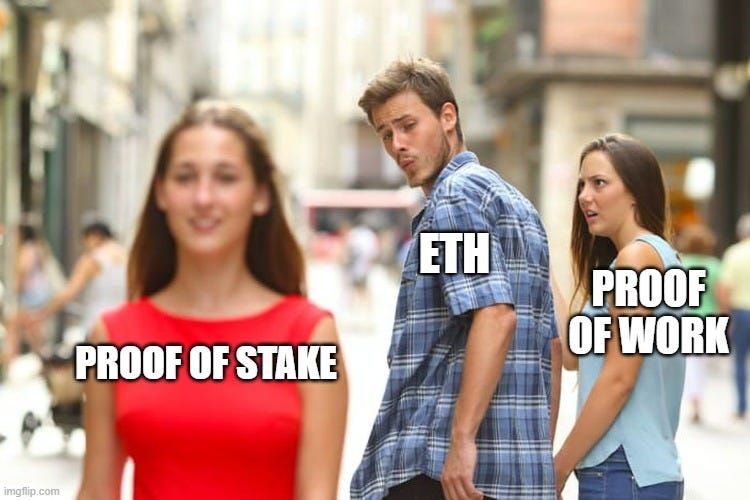The defining characteristic of cryptocurrencies, a force that is set to do to banks what email did to the postal service, is that they’re decentralized. If you’re new to the cryptocurrency world, you could have heard promoters say decentralization of crypto’s main benefit.
Nonetheless, the absence of a central authority that verifies transactions is a real challenge. Cryptocurrencies overcome this challenge using proof of work (PoW) or proof of stake (PoS).
If you’ve constantly been walking a tightrope between expertise and creativity, bias and openness, experience and epiphany, ambition and passion, arrogance and conviction on this subject, don’t let blind faith and the curiosity that killed the cat or you could end up being the suspect. Since curiosity is the wick in your candle of learning, let’s help you decipher it.
Read more: Cryptocurrency 101: A Beginner’s Guide to Understanding Cryptocurrencies, and Their Advantages

Cryptocurrency, crypto-currency, or simply crypto, is a digital or virtual currency that secures transactions using cryptography. Since cryptocurrencies don’t have central issuing or regulating authorities, they use decentralized systems to issue new units and record transactions.
Cryptocurrencies exist on the blockchain, a distributed public ledger that records all transactions as they are updated and held by crypto holders. Blockchain is simply a description of how transactions are recorded as “blocks” and time stamped.
The proof of stake and proof of work are consensus methods that ensure users can perform safe and secure transactions while making it tricky and expensive for evil characters like the infamous South Korean-based Lazarus Group that thrive on making fraudulent transactions. These methods offer a way for participants to prove they provided resources like funds, computing power, or energy to the blockchain.
The primary difference between proof of work (PoW) and proof of stake (PoW) is the method used by the blockchain algorithm to qualify and choose users who add transactions to the blockchain.
Proof of Work (PoW)
Definition and Explanation of PoW
Proof of work (PoW) refers to a system of adding new blocks of transactions to blockchains. The work involves generating a long string of characters (hash) that need to match the target for that current block; it’s something comparable to trying to solve a Rubik’s cube. The crypto miner who manages to match the string of characters using their specialized computer wins the right to add the block to the system and receives a reward in exchange.
How PoW Works
The PoW mechanism incentivizes network validation by rewarding miners who add computational power and difficulty to the network. The lottery-like system ensures different miners have a chance to receive the reward.
If you send a Bitcoin to someone, the transaction will be registered on a block with other transactions and is communicated to the network, where different miners use their computing power to validate it.
The nodes (computers) within the network compete against each other to find a solution to validate the complex mathematical riddle using a trial-and-error basis until one node finds the correct number and communicates to the other nodes.
Consensus is achieved when the majority of the nodes agree the miner has solved the riddle. The miner is rewarded with transaction fees for having used their computational power, energy, and time. The proof of work protocol that facilitates validation exists to prevent transactions from being falsified.
The “work” refers to the computational power miners have to contribute to validating new blocks of transactions.
Mining Process in PoW
Cryptocurrency miners use significant amounts of computer power and energy to solve complex math problems to validate transactions in exchange for a reward. This is how the process works:
New transactions are grouped: As users, traders, or investors buy or sell crypto, the transaction data is pooled into a block.
Miners compete for the right to process the new block: Miners compete by trying to become the first ones to solve the complex math puzzle. Miners win the right to process a transaction when they prove they participated in the computational work – called a hash.
Miner is chosen to add a new block: The system will randomly choose the miner to process the new block and add it to the blockchain, and they get rewarded with new crypto coins.
Security Aspects of PoW
There’s a strong track record showing the proof of work (PoW) mechanism offers robust security, mainly because of the massive amount of power used for adding blocks to the blockchain. This aspect makes it difficult and expensive for malicious players to gather enough computational power to approve fraudulent transactions or manipulate the blockchain since Bitcoin mining alone consumes as much electricity as a medium-sized European country.
Energy Consumption in PoW
Energy consumption is the greatest undoing of the PoW mechanism. Per a New York Times report, you needed a negligible amount of power to mine one Bitcoin using a regular computer in 2009. However, by 2021, the electricity you needed to mine one Bitcoin would run a standard American Home for nine years.
Examples of Сryptocurrencies using PoW
It’s estimated that over 64% of the market capitalization of cryptocurrencies use proof of work, with the most famous examples of cryptos being Bitcoin, Dogecoin, Bitcoin Cash, Litecoin, and Monero, among others.

Proof of Stake (PoS)
Definition and Explanation of PoS
Proof of stake (PoS) is a consensus mechanism that selects the person to validate the next block of transactions based on the number of crypto coins they hold instead of expending computational energy cracking computational puzzles.
The prospect of a participant validating a new block depends on the size of their stake. The persons staking, called validators, don’t receive block rewards but are instead compensated using network fees as a reward.
How PoS Works
Staking refers to people agreeing to lock up a certain amount of crypto coins to get the opportunity to become validators who add new blocks of data to the blockchain. The validators, or stakers, deposit their cryptocurrency into a smart contract that the blockchain holds.
The blockchain algorithm will choose validators responsible for checking new data blocks based on the amount of crypto they staked.
As a rule of thumb, the greater the amount staked, the greater the chances of being selected to do the work. When the data cleared by a validator gets added to the blockchain, they get rewarded with a portion of the newly minted coins.
Role of Validators in PoS
It’s the participant’s business to verify that transactions are genuine before they can get added to the blockchain, thereby helping to achieve consensus. These participants, called validators, will have locked in a set amount of their crypto tokens in a blockchain smart contract as a stake.
The validators then get to validate new transactions in exchange for a reward. Nonetheless, all this comes with a rider because validators get penalized if they validate flawed or fraudulent transactions, where they could lose a portion or the entire amount of their stake as a penalty.
Security Aspects of PoS
While the PoS mechanism may be considered relatively secure, some pundits believe the system is relatively vulnerable to attacks compared to PoW. While the staked amount can become a deterrent for validators who may want to do any money business for fear of losing their funds if detected, there’s still considerable debate regarding its comparative security compared to the PoW mechanism’s security.
Energy Efficiency in PoS
As far as energy consumption is concerned, the proof of stake consensus mechanism isn’t as energy-hungry as the proof of work method, seeing that it doesn’t require much computational power. Instead, the mechanism relies on an algorithmic selection method based on the amount of crypto funds a validator has staked. Since there are no math puzzles that need to be solved, less energy is consumed, leading to faster transaction verification.
Examples of Cryptocurrencies using PoS
As the world is increasingly getting concerned about greenhouse gas emissions and the carbon footprint of all our activities, the proof of stake mechanism is getting increasingly popular. There are currently over 80 cryptocurrencies ascribing to the PoS method, which include Ethereum, Cardano, Tron, EOS, Cosmos, and Tezos, among others. It’s no wonder Ethereum co-founder Vitalik Buterin once stated Ethereum was moving to proof of stake (PoS) when asked whether there was anything he had insane confidence in but had since discovered he was dead wrong.
Differences Between PoW and PoS
Proof of Work (PoW)
- The likelihood of mining a block depends on the computational power a miner puts in.
- It’s the first miner to solve the math puzzle that receives the reward.
- Miners use their computing power to compete to solve the cryptographic puzzle before they can add a block to the chain.
- Hackers need over 51% computing power to add a malicious block successfully.
- PoW systems are energy-consuming but more proven.
- Miners need expensive specialized equipment.
- You need to invest heavily to buy hardware.
Proof of Stake (PoS)
- The chances of validating a block depend on the amount of crypto you stake.
- Validators collect network fees as a reward instead of a block reward.
- There’s no competition since a validator is selected randomly based on their stake.
- A hacker would require 51% of the entire crypto amount on the network, something that’s practically impossible.
- PoS systems are more costly but more energy efficient.
- You only need a standard computer to become a validator.
- The only investment you need is buying a stake and building a reputation.
Conclusion
Cryptocurrency has entered an exciting phase of its existence. Even traditional financial institutions that assumed it’s going away are discovering it’s going mainstream, and it’s here to stay.
Learn More About:
While others struggle with ideas of crypto being weird and shrug their shoulders, saying they can’t get it, you can no longer ignore the difference between proof of work and proof of stake and just be fine.

Your best approach will be determined by what you value since both have different advantages and disadvantages. Still, most importantly, you want to understand how both mechanisms work before you can make a decision.
Disclaimer: All materials on this site are for informational purposes only. None of the material should be interpreted as investment advice. Please note that despite the nature of much of the material created and hosted on this website, HODL.FM is not a financial reference resource and the opinions of authors and other contributors are their own and should not be taken as financial advice. If you require advice of this sort, HODL.FM strongly recommends contacting a qualified industry professional.









